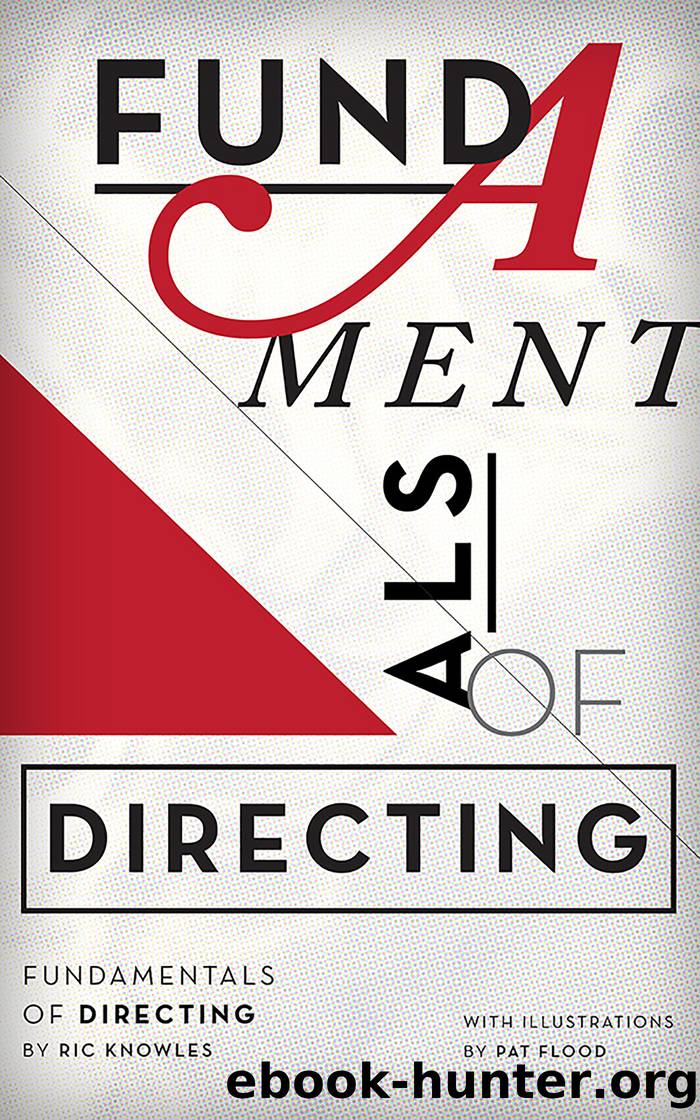Fundamentals of Directing by Ric Knowles

Author:Ric Knowles [Knowles, Ric]
Language: eng
Format: epub
ISBN: 9781770914728
Publisher: Playwrights Canada Press
Published: 2015-08-17T00:00:00+00:00
Figure 9: Blocking for focus on a thrust stage.
Effective positioning in traverse and in-the-round arrangements tends more frequently to be determined by levels and by the strategic arrangement of actors and furnishings. In these as well as in thrust configurations a director has to make sure that whenever possible all audience members are able to see at least one actorâs face at all times.
Knowledge of the stageâs strongest positionings is an invaluable tool, but itâs important not to rely on these too heavily because doing so will soon become boring: save them for key moments.
Otherwise focus can be achieved in a variety of ways. One is through the positioning of actors in groups that work to direct audiencesâ attention. A huddle of actors upstage right on a proscenium looking intently at (or even pointing toward) a solo actor down centre will ensure that if the audienceâs gaze wanders it will be redirected appropriately (figure 8). A similar effect can be achieved on a thrust stage with actors distributed around the edge of the thrust, looking toward the stage centre action (figure 9).
Another key tool for the achievement of focus is the strategic use of stillness, or of movement that draws the eye. This can range from large, cross-stage sweeps that function like a cameraâs pan to refocus audience attention by drawing the eye from one side of the stage to the other, to the use of frenetic downstage movement that is set in contrast to the stillness of a solo figure upstage. Depending on the context, either movement or stillness can draw the eye: stillness is powerful on an otherwise busy stage; movement is compelling when all else is still.
Itâs even possible to make use of something as small as a tiny gesture on an otherwise still stage, which can make the audience focus on a single detail with the same effectiveness as a cameraâs close-up. Indeed, the flicker of an eyelash will be the centre of focus on an otherwise still body on an otherwise still stage. A smile from the same actor will broaden the focus to her head, a gesture with her arm will broaden it further to her upper body, a subsequent movement of her foot to her entire body, and so on. As other actors begin gradually to move, the eye, like a camera, will zoom out for a wide-angle view of the whole stage.
Stage composition is the art of making each moment on the stage look good (or look bad in strategic ways) and perhaps more importantly of communicating meaning and emotion visually. Initial rules of thumb involve avoiding static images, which usually involve arranging actors in straight lines that are parallel or perpendicular to the front or sides of the stage (in the case of proscenium, thrust, or traverse configurations). They also involve avoiding compositions that are meaninglessly or distractingly imbalanced while keeping things dynamic (not letting them becoming boringly or predictably balanced).
Often productive tensions can be initiated and resolved by playing
Download
This site does not store any files on its server. We only index and link to content provided by other sites. Please contact the content providers to delete copyright contents if any and email us, we'll remove relevant links or contents immediately.
| African | Asian |
| Australia & Oceania | Canadian |
| Caribbean & Latin American | European |
| Middle Eastern | Russian |
| United States |
Cecilia; Or, Memoirs of an Heiress — Volume 3 by Fanny Burney(31827)
Cecilia; Or, Memoirs of an Heiress — Volume 2 by Fanny Burney(31816)
Dialogue by Robert McKee(4311)
The 101 Dalmatians by Dodie Smith(3440)
Bound by Hatred (The Singham Bloodlines Book 2) by MV Kasi(3018)
The Art of Dramatic Writing: Its Basis in the Creative Interpretation of Human Motives by Egri Lajos(3002)
Harry Potter and the Cursed Child - Parts One and Two by John Tiffany(2993)
The Beautiful Boys: A High School NA Reverse Harem Paranormal Bully Romance (Shadowlight Academy Book 1) by Gow Kailin(2821)
Angels in America by Tony Kushner(2547)
Carrie's War by Nina Bawden(2421)
A Clockwork Orange by Anthony Burgess(2399)
Unlaced by Jaci Burton & Jasmine Haynes & Joey W. Hill & Denise Rossetti(2318)
The Femme Playlist & I Cannot Lie to the Stars That Made Me by Catherine Hernandez(2238)
Open Book by Jessica Simpson(2195)
Drama by John Lithgow(2183)
Outside Woman (BWWM Amish Romance) by Stacy-Deanne(2072)
Terrorist Cop by Mordecai Dzikansky & ROBERT SLATER(2025)
Yerma by Federico García Lorca(2006)
Leo's Desire by Sundari Venkatraman(1891)
